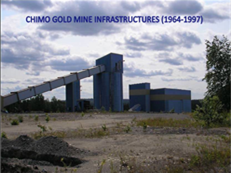![]() Cartier Resources Inc.{TSX.V: ECR}
Cartier Resources Inc.{TSX.V: ECR}
Resumed phase 3 drilling on the Chimo mine property,45 kilometres east of Val d’Or.
Two drills are currently exploring the geometric extensions of zones 5B4-5M4-5NE gold discovery, which follow excellent results reported last June.
.
.
.

.
.
.
Cartier Resources resumes drilling at Chimo
2019-11-27 04:07 ET – News Release
Mr. Philippe Cloutier reports
CARTIER DRILLING BELOW ZONES 5B4-5M4-5NE DISCOVERY AT CHIMO MINE
.
.
Cartier Resources Inc. has resumed phase 3 drilling on the Chimo mine property, located 45 kilometres east of Val d’Or. Two drills are currently exploring the geometric extensions of zones 5B4-5M4-5NE gold discovery, which follow excellent results reported last June (5.6 grams per tonne gold over 8.5 metres including 9.9 g/t Au over 3.0 m and 8.3 g/t Au over 2.5 m, all included in a mineralised envelope of 27.8 m grading 2.5 g/t Au). This program consists of 7,000 m of directional drilling and targets a dozen intersections in the gold zones, via two pilot holes.
.
“Drilling on zones 5B4-5M4-5NE recently led to the development of new gold resources and currently represents the best exploration potential on the property,” commented Philippe Cloutier, president and chief executive officer. He added that, “This potential is in addition to the current resource estimate of the North and South gold corridor as well as the drilling of zone 6N1.”
.
Mineralisation of the Chimo mine property consists of 25 gold zones within 16 gold structures, which are grouped into three gold-bearing corridors. On Nov. 5, via its press release titled, “Cartier Publishes its First Mineral Resource Estimate of the Central Gold Corridor on the Chimo Mine property,” the company reported its first resource estimate for the Chimo mine property. The resource estimate was produced on the Central gold corridor, which hosts zones 5B, 5B2, 5B4, 5C, 5M, 5M2, 5M3, 5M4, 5N, 5NE and 6N1. Using a gold price of $1,292 (U.S.) per ounce and a cut-off grade of 2.5 g/t Au the resource estimated yielded:
- 461,280 ounces of gold in the indicated resource category from 3,263,300 tonnes at an average grade of 4.40 g/t Au;
- 417,250 ounces of gold in the inferred resource category from 3,681,600 tonnes at an average grade of 3.53 g/t Au.
.
A resource estimate is in progress for the Northern gold corridor, which consists of zones 1A, 1B, 2B, 2, 2W, 3, 3E, 3W, 4B and 4B2, as well as for the Southern gold corridor, which consists of zones 6, 6B, 6P and 6P2.
.
In addition, approximately 4,000 m of drilling is being planned to explore the peripheral extensions of zone 6N1, which is only 125 m away from the underground infrastructure.
.
Chimo mine project highlights:
- Cartier holds a 100-per-cent interest in the property for which 1-per-cent NSR royalty has been granted to Iamgold Corp. No rights of first refusal have been granted.
- The property, which is accessible year-round, is located near six mills in the Val d’Or area.
- Fourteen gold zones were exploited by three producers between 1964 and 1997 for a production of 379,012 ounces of gold (MERN DV 85-05 to DV-97-01).
- The mining infrastructure consists of a network of drifts over seven kilometres, distributed over 19 levels and connected by a 5.5 m by 1.8 m three-compartment shaft with a depth of 920 m. Twenty sublevels and raises are also present. The headframe and the surface installations were dismantled in 2008 but the 25-kilovolt power line and the sand pit are still in place.
- The recent drilling of phases 1, 2 and 3, completed to date by Cartier on the Chimo mine property, consists of 109 holes totalling 49,251 m. This work demonstrated the continuity of the main 5B and 5M gold zones under the existing mining infrastructure, explored the extensions of 19 gold zones peripheral to the main zones and explored the extensions of the seven gold zones that were prioritized, which allowed the discovery of the zones 5B4-5M4-5NE and to develop the potential of zone 6N1. These areas have excellent potential to deliver future discoveries.
.
.
.











